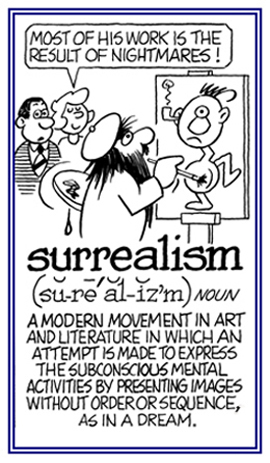-ism, -ismus
(Greek, ismos; Latin, ismus: a suffix: belief in, practice of, condition of, process, characteristic behavior or manner, abnormal state, distinctive feature or trait)
supralapsarianism
The doctrine, belief, or principles of the Supralapsarians.
suprematism
A nonrepresentational school of cubist painting style of art developed in Russia in the early 20th century, characterized by severely simple geometric shapes or forms and an extremely limited palette.
1. An early 20th-century movement in art and literature that tried to represent the subconscious mind by creating fantastic imagery by emphasizing imaginative powers including concepts that seem to contradict each other: Surrealism is used for the fine arts and written works in which unusual or impossible things are revealed as they happen.

© ALL rights are reserved.
Go to this Word A Day Revisited Index
One of the primary objectives of surrealism is to go beyond the ordinary processes of thinking and logic by existing in a mental world and in dreams.
2. Etymology: from French surréalisme; from Latin sur-, "above, beyond" + réalisme, "realism".Created in 1917 by Guillaume Apollinaire, and then taken over by Andre Breton as the name of the movement he launched in 1924 with Manifeste de Surréalisme.

Go to this Word A Day Revisited Index
so you can see more of Mickey Bach's cartoons.
The practice of self-serving or servile flattery: "Sabina's supervisor was aware that she was trying to use sycophantism in order to gain more job advantages from him."
1. An argument or form of reasoning in which two statements or premises are made and a logical conclusion drawn from them: All mammals are warm-blooded (major premise); whales are mammals (minor premise); therefore, whales are warm-blooded (conclusion).
2. Reasoning from the general to the particular; deductive logic: A syllogism can be an instance of subtle, tricky, or specious reasoning; or one that seems to be true but is actually false or deceptive.
2. Reasoning from the general to the particular; deductive logic: A syllogism can be an instance of subtle, tricky, or specious reasoning; or one that seems to be true but is actually false or deceptive.
symbiotism
1. Living together, social life.
2. Association of two different organisms (usually two plants, or an animal and a plant) which live attached to each other, or one as a tenant of the other, and contribute to each other’s support.
4. The mutual cooperation or interdependence of two people, as mother and infant, or husband and wife; sometimes used to denote excessive or pathological interdependence of two persons.
2. Association of two different organisms (usually two plants, or an animal and a plant) which live attached to each other, or one as a tenant of the other, and contribute to each other’s support.
Also more widely, any intimate association of two or more different organisms, whether mutually beneficial or not.
3. The biological association of two or more species for their mutual benefit.4. The mutual cooperation or interdependence of two people, as mother and infant, or husband and wife; sometimes used to denote excessive or pathological interdependence of two persons.
![]() Here is more information and several illustrations about symbiosis.
Here is more information and several illustrations about symbiosis.
symbolism
1. The practice of representing things by symbols, or of investing things with a symbolic meaning or character.
2. The disguised representation in conscious thought of unconscious or repressed contents or events.
3. A set or system of symbols.
4. A symbolic meaning or character.
5. The principles and practice of symbolists in art or literature.
6. When capitlized, a movement of the late 19th century in French art and literature.
7. The use of any of certain special figures or marks of identification to signify a religious message or divine being, as the cross for Christ and the Christian faith.
2. The disguised representation in conscious thought of unconscious or repressed contents or events.
3. A set or system of symbols.
4. A symbolic meaning or character.
5. The principles and practice of symbolists in art or literature.
6. When capitlized, a movement of the late 19th century in French art and literature.
7. The use of any of certain special figures or marks of identification to signify a religious message or divine being, as the cross for Christ and the Christian faith.
symbrachydactylism
A situation in which the fingers are abnormally short and partially united with webbing.
sympathism
1. Responsiveness or susceptibility to a psychological process; such as, a hypnotic command whereby an idea is induced into, or adopted by, an individual without argument, command, or coercion.
2. An assumed occult influenee of one mind upon another mind, inducing similarity of sensations and of emotions.
2. An assumed occult influenee of one mind upon another mind, inducing similarity of sensations and of emotions.
symphytism
syncliticism
synclitism
syndactylism
A birth defect in which there is partial, or total, webbing connecting two or more fingers or toes.
synergism
synorchidism


